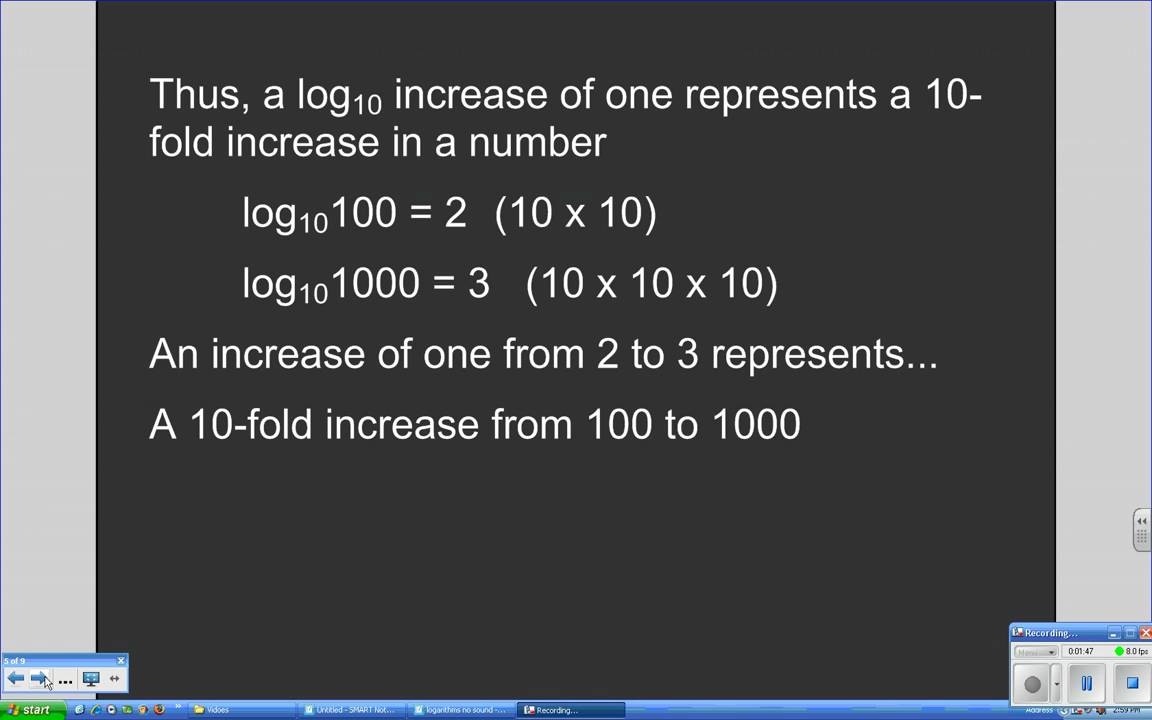Logarithms | Logarithms | Algebra II | Khan Academy
Summary
TLDRThis video introduces the concept of logarithms, explaining how they are the inverse of exponents. Through simple examples like log base 2 of 16 and log base 3 of 81, the script illustrates how logarithms help us find the power to which a number must be raised to reach another value. The video explores several logarithmic expressions, demonstrating the step-by-step process of evaluating them without relying on complex algebra. It emphasizes that log base of 1 is always 0, providing a foundational understanding of logarithmic functions.
Takeaways
- 😀 Logarithms are used to determine the power to which a base number must be raised to reach a specific value.
- 😀 The example of 2^4 = 16 demonstrates how exponents work, and logarithms help reverse this process to find the exponent.
- 😀 The notation log base 2 of 16 asks, 'What power must 2 be raised to in order to get 16?' The answer is 4.
- 😀 Logarithmic expressions and their equivalent exponential forms are interchangeable. For example, log base 3 of 81 equals 4 because 3^4 = 81.
- 😀 Understanding logarithms involves finding the power required to reach a target value using a given base, such as log base 3 of 81, which equals 4.
- 😀 When evaluating logarithmic expressions, you can test powers of the base to find the correct exponent.
- 😀 Logarithms are a more straightforward way to express exponents without needing to solve for 'x' explicitly in an equation.
- 😀 Logarithms can be evaluated using trial and error, such as by calculating powers of 3 to find log base 3 of 81 = 4.
- 😀 In the case of log base 2 of 64, the exponent is 6 because 2^6 = 64.
- 😀 Logarithms have a fundamental property where the log base 'a' of 1 is always 0, because any non-zero number raised to the power of 0 equals 1 (e.g., log base 100 of 1 = 0).
Q & A
What does '2 to the fourth power' mean?
-'2 to the fourth power' means multiplying 2 by itself four times: 2 × 2 × 2 × 2, which equals 16.
How is logarithmic notation used to express an exponent?
-Logarithmic notation expresses an exponent by asking 'What power must the base be raised to in order to get a specific value?'. For example, log base 2 of 16 asks 'What power must 2 be raised to in order to get 16?' The answer is 4.
What does log base 2 of 16 represent?
-Log base 2 of 16 asks for the power to which 2 must be raised to produce 16. Since 2 to the power of 4 equals 16, log base 2 of 16 equals 4.
How does the expression 'log base 3 of 81' work?
-Log base 3 of 81 asks for the exponent to which 3 must be raised to get 81. Since 3 raised to the power of 4 equals 81, log base 3 of 81 equals 4.
Why is the concept of logarithms useful?
-Logarithms are useful because they help determine the unknown exponent (or power) that results in a particular value, making calculations involving exponents more manageable, especially in fields like science, engineering, and finance.
What is the advantage of using logarithms instead of algebra to find exponents?
-Logarithms simplify the process of determining exponents by directly answering the question of what power a number must be raised to, without the need to perform repetitive multiplication or use algebraic manipulations.
How can logarithms be evaluated without algebra?
-Logarithms can be evaluated by recognizing patterns in powers of numbers. For example, instead of solving for 'x' algebraically, you can find the power directly by experimentation, such as recognizing that 3^4 equals 81 when evaluating log base 3 of 81.
What is the result of log base 6 of 216?
-Log base 6 of 216 asks for the power to which 6 must be raised to produce 216. Since 6 raised to the power of 3 equals 216, log base 6 of 216 equals 3.
What does log base 2 of 64 evaluate to?
-Log base 2 of 64 asks for the exponent to which 2 must be raised to get 64. Since 2 raised to the power of 6 equals 64, log base 2 of 64 equals 6.
What is the value of log base 100 of 1?
-Log base 100 of 1 asks for the power to which 100 must be raised to get 1. Since any non-zero number raised to the power of 0 equals 1, log base 100 of 1 equals 0.
Outlines

此内容仅限付费用户访问。 请升级后访问。
立即升级Mindmap

此内容仅限付费用户访问。 请升级后访问。
立即升级Keywords

此内容仅限付费用户访问。 请升级后访问。
立即升级Highlights

此内容仅限付费用户访问。 请升级后访问。
立即升级Transcripts

此内容仅限付费用户访问。 请升级后访问。
立即升级5.0 / 5 (0 votes)






